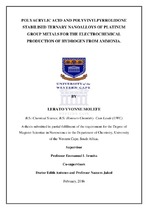| dc.description.abstract | The electrochemical oxidation of ammonia has attracted much attention as an efficient green method for application in direct ammonia fuel cells (DAFCs) and the production of high purity hydrogen. However, the insufficient performance and high costs of platinum has hindered the large scale application of ammonia (NH₃) electro-oxidation technologies. Therefore, there is a need for the fabrication of efficient electrocatalysts for NH₃ electrooxidation with improved activity and lower Pt loading. Owing to their unique catalytic properties, nanoalloys of platinum group metals (PGMs) are being designated as possible electrocatalysts for NH₃ oxidation. This study presents for the first time a chemical synthesis of unsupported ternary PGM based nanoalloys such as Cu@Pt@Ir with multi-shell structures and Cu-Pt-Ir mixed nanoalloys for electro-catalysis of NH3 oxidation. The nanoalloys were stabilised with polyvinylpyrrolidone (PVP) as the capping agent. The structural properties of the nanoalloys were studied using ultraviolet-visible (UV-Vis) and fourier transform infra-red (FTIR) spectroscopic techniques. The elemental composition, average particle size and morphology of the materials were evaluated by high resolution transmission electron microscopy (HRTEM) coupled to energy dispersive X-ray (EDX) spectroscopy. High resolution scanning electron microscopy (HRSEM) was used for morphological characterisation. Additionally, scanning auger nanoprobe microscopy (NanoSAM) was employed to provide high performance auger (AES) spectral analysis and auger imaging of complex multi-layered Cu@Pt@Ir nanoalloy surface. X-ray diffraction (XRD) spectroscopy was used to investigate the crystallinity of the nanoalloys. The electrochemistry of the nanoalloy materials was interrogated with cyclic voltammetry (CV) and square wave voltammetry (SWV). The electrocatalytic activity of novel Cu-Pt-Ir trimetallic nanoalloys for the oxidation of ammonia was tested using CV. UV-Vis spectroscopy confirmed the complete reduction of the metal precursors to the respective nanoparticles. FTIR spectroscopy confirmed the presence of the PVP polymer as well as formation of a bond between the polymer (PVP) chains and the metal surface for all nanoparticles (NPs). Furthermore, HRTEM confirmed that the small irregular interconnected PVP stabilised Cu@Pt@Ir NPs were about 5 nm in size. The elemental composition of the alloy nanoparticles measured using EDX also confirmed the presence of Cu, Pt and Ir. Cyclic voltammetry indicated that both the GCE|Cu-Pt-Ir NPs and GCE|Cu@Pt@Ir NPs are active electrocatalysts for NH3 oxidation as witnessed by the formation of a well-defined anodic peak around -0.298 V (vs. Ag/AgCl). Thus the GCE|Cu-Pt-Ir NPs was found to be a suitable electrocatalyst that enhances the kinetics of oxidation of ammonia at reduced overpotential and high peak current in comparison with GCE|Cu@Pt@Ir NPs, GCE|Pt NPs, GCE|Ir NPs and GCE|Cu NPs electrocatalysts. The presence of the crystalline phases in each sample was confirmed by XRD analysis. The surface analysis of Cu@Pt@Ir nanoalloy with AES surveys revealed the presence of Pt, Ir and Cu elements in all probed spots suggesting some mixing between the layers of the nanoalloy. Yet, analysis of nanoalloys by CV and XRD confirmed the presence of Cu-Pt and Pt-Ir solid solutions in the Cu-Pt-Ir and Cu@Pt@Ir nanoalloys respectively. | en_US |

